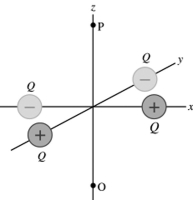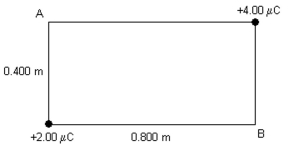Correct Answer

verified
Correct Answer
verified
Multiple Choice
A 3.0-pFcapacitor consists of two large closely-spaced parallel plates that have surface charge densities of If the potential across the plates is with only air between them, find the surface area of each of the plates. (ε0 = 8.85 × 10-12 C2/N ∙ m2)
A) 69 mm2
B) 0.014 mm2
C) 35 mm2
D) 0.0072 mm2
Correct Answer

verified
Correct Answer
verified
Multiple Choice
A proton moves 0.10 m along the direction of an electric field of magnitude 3.0 V/m. What is the change in kinetic energy of the proton? (e = 1.60 × 10-19 C)
A) 4.8 × 10-20 J
B) 3.2 × 10-20 J
C) 1.6 × 10-20 J
D) 8.0 × 10-21 J
Correct Answer

verified
Correct Answer
verified
Multiple Choice
How much energy is necessary to place three +2.0-µC point charges at the vertices of an equilateral triangle of side 2.0 cm if they started out extremely far away? (k = 1/4πε0 = 9.0 × 109 N ∙ m2/C2)
A) 4.5 J
B) 5.4 J
C) 6.7 J
D) 7.6 J
Correct Answer

verified
Correct Answer
verified
Multiple Choice
Two isolated copper plates, each of area 0.40 m2, carry opposite charges of magnitude 7.08 × 10-10 C. They are placed opposite each other in parallel alignment, with a spacing of 4.0 cm between them. What is the potential difference between the plates? (ε0 = 8.85 × 10-12 C2/N ∙ m2)
A) 0.40 V
B) 3.0 V
C) 3.2 V
D) 7.6 V
E) 8.0 V
Correct Answer

verified
Correct Answer
verified
Multiple Choice
The plates of a parallel-plate capacitor are maintained with constant voltage by a battery as they are pulled apart. What happens to the strength of the electric field between the plates during this process?
A) It increases.
B) It decreases.
C) It remains constant.
D) It cannot be determined from the information given.
Correct Answer

verified
Correct Answer
verified
Multiple Choice
An ideal parallel-plate capacitor consists of two parallel plates of area A separated by a distance d. This capacitor is connected to a battery that maintains a constant potential difference across the plates. If the separation between the plates is now doubled, the amount of electrical energy stored on the capacitor will
A) double.
B) quadruple.
C) be cut in half.
D) be cut in fourth.
E) not change.
Correct Answer

verified
Correct Answer
verified
Multiple Choice
The electron-volt is a unit of
A) charge.
B) electric potential.
C) electric field.
D) electric force.
E) energy.
Correct Answer

verified
Correct Answer
verified
Multiple Choice
Four charged particles (two having a charge +Q and two having a charge -Q) are arranged in the xy-plane, as shown in the figure. These particles are all equidistant from the origin. The electric potential (relative to infinity) at point P on the z-axis due to these particles, is 
A) zero.
B) positive.
C) negative.
D) impossible to determine based on the information given.
Correct Answer

verified
Correct Answer
verified
Multiple Choice
Four point charges of magnitude 6.00 μC and are at the corners of a square 2.00 m on each side. Two of the charges are positive, and two are negative. What is the electric potential at the center of this square, relative to infinity, due to these charges? (k = 1/4πε0 = 8.99 × 109 N ∙ m2/C2)
A) 76.4 kV
B) 0 V
C) 153 kV
D) 61.0 kV
E) 306 kV
Correct Answer

verified
Correct Answer
verified
Multiple Choice
An air-filled 20-μF capacitor has a charge of 60 μC on its plates. How much energy is stored in this capacitor?
A) 70 μJ
B) 80 μJ
C) 90 μJ
D) 100 μJ
E) 110 μJ
Correct Answer

verified
Correct Answer
verified
Multiple Choice
Point charges +4.00 μC and +2.00 μC are placed at the opposite corners of a rectangle as shown in the figure. What is the potential difference VA - VB? (k = 1/4πε0 = 8.99 × 109 N ∙ m2/C2) 
A) +203 kV
B) -203 kV
C) -22.5 kV
D) +22.5 kV
E) 0.00 kV
Correct Answer

verified
Correct Answer
verified
Multiple Choice
Two +6.0-µC charges are placed at two of the vertices of an equilateral triangle having sides 2.0 m long. What is the electric potential at the third vertex, relative to infinity, due to these charges? (k = 1/4πε0 = 9.0 × 109 N ∙ m2/C2)
A) 54 kV
B) 108 V
C) 0 V
D) 90 kV
E) 27 kV
Correct Answer

verified
Correct Answer
verified
Multiple Choice
A battery charges a parallel-plate capacitor fully and then is removed. The plates are then slowly pulled apart. What happens to the potential difference between the plates as they are being separated?
A) It increases.
B) It decreases.
C) It remains constant.
D) It cannot be determined from the information given.
Correct Answer

verified
Correct Answer
verified
Multiple Choice
A +5.0-nC charge is at the point (0.00 m, 0.00 m) and a -2.0-nC charge is at (3.0 m, 0.00 m) . What work is required to bring a 1.0-nC charge from very far away to point (0.00 m, 4.0 m) ? (k = 1/4πε0 = 9.0 × 109 N ∙ m2/C2)
A) 15 nJ
B) 3.6 nJ
C) 11 nJ
D) 7.7 nJ
Correct Answer

verified
Correct Answer
verified
Multiple Choice
A region of space contains a uniform electric field, directed toward the right, as shown in the figure. Which statement about this situation is correct? 
A) The potential at all three locations is the same.
B) The potentials at points A and B are equal, and the potential at point C is higher than the potential at point A.
C) The potential at points A and B are equal, and the potential at point C is lower than the potential at point A.
D) The potential at point A is the highest, the potential at point B is the second highest, and the potential at point C is the lowest.
Correct Answer

verified
Correct Answer
verified
Multiple Choice
If you want to store 2.0 mJ of energy in a 10-μF capacitor, how much potential do you need to put across it?
A) 5.0 V
B) 10 V
C) 15 V
D) 20 V
Correct Answer

verified
Correct Answer
verified
Multiple Choice
A capacitor has a voltage of 391 applied across its plates, and then the voltage source is removed. What is the potential difference across its plates if the space between them is then filled with mica, having a dielectric constant of 5.4?
A) 72 V
B) 2110 V
C) 641 V
D) 18,675 V
Correct Answer

verified
Correct Answer
verified
Multiple Choice
A space probe approaches a planet, taking measurements as it goes. If it detects a potential difference of 6000 MV between the altitudes of 253,000 km and 276,000 km above the planet's surface, what is the approximate electric field strength produced by the planet at 264,500 km above the surface? Assume the electric field strength is approximately constant at these altitudes.
A) 261 N/C
B) 0.261 N/C
C) 561 N/C
D) 493 μN/C
Correct Answer

verified
Correct Answer
verified
Short Answer
Two tiny particles having charges q1 = +56.0 nC and q2 = -46.0 nC are separated by and held in place, as shown in the figure. A third particle, having a charge of is placed at the point A, which is 0.18 m to the left of q2. How much work is needed to move the third particle from point A to point B, which is 0.40 m to the left of q1. All the points in the figure lie on the same line. (k = 1/4πε0 = 9.0 × 109 N ∙ m2/C2) 
Correct Answer

verified
Correct Answer
verified
Showing 101 - 120 of 144
Related Exams